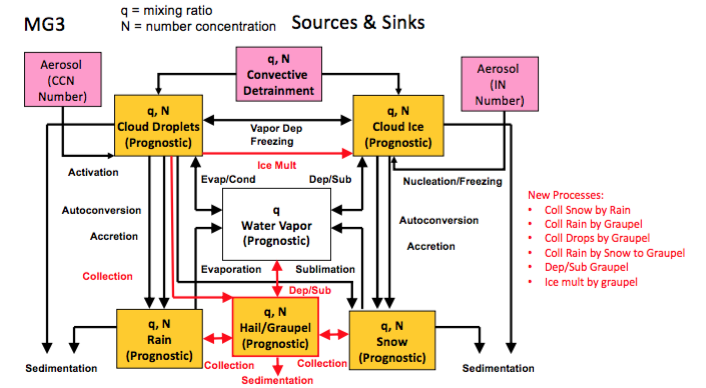Description
The Morrison-Gettelman Version 3 (MG3) microphysics scheme is a six-category double momentum bulk scheme. It forecasts mass and number concentration of five hydrometeors (cloud water, cloud ice, rain, snow and graupel) in addition to mass of water vapor.
Morrison Gettelman Advancements
- MG1: Morrison and Gettelman (2008) [128] (CESM1, CAM5)
- Morrison et al 2005 scheme
- Added sub-grid scale variance
- Coupling to activation (aerosols)
- MG2: Gettelman and Morrison (2015) [64] [66] (CESM2, CAM6)
- Prognostic precipitation (rain and snow)
- Sub-stepping and sub-column capable
- MG3: Gettelman et al. (2019) [67]
- Rimed hydrometeors (graupel or hail) are added to stratiform cloud scheme for global models
- Global climate impacts are limited to small increased in ice mass
- High (14 km) resolution simulations show local production of rimed ice (graupel) can affect regional precipitation amounts and intensity
A schematic of the MG3 scheme is shown in Figure 1. MG3 starts with MG2 [64] [66] and adds a series of processes (in red). One rimed hydrometeor category is added. Both mass and number are prognosed. Rimed ice has the "character" of hail or graupel by pre-selecting density and fall speed parameters.

Figure 1: A schematic of the MG3 scheme (Courtesy of A. Gettleman )
Some unique attributes of MG3 cloud microphysics include:
- Consistent treatment of cloud fraction in cloud macrophysics and radiation
- Subgrid-scale microphysics
- Maximum-overlap and in-cloud precipitation fraction area
- Options for subcolumn microphysics
- Options for running with fewer species and processes, simulating MG1 and MG2 codes
- Completely aerosol awareness with 1) constant aerosol mixing ratio, 2) climatology IN/CCN from CAM5 (default;
cam5_4_143_NAAI_monclimo2.nc), 3) climatology aerosol from MERRA2 , 4) GOCART, and 5) MAM7
- Sub-step semi-implicit sedimentation
- Can be used along with the FV in-core saturation adjustment
Intraphysics Communication
Argument Table
General Algorithm
MG m_micro_run Detailed Algorithm
